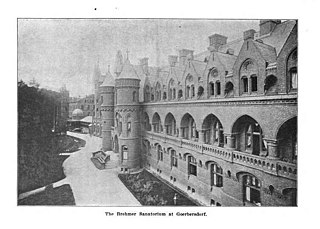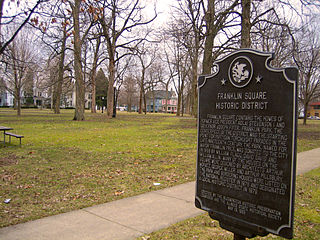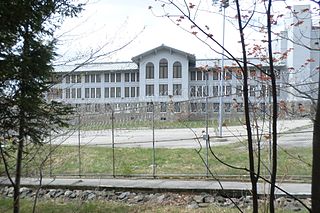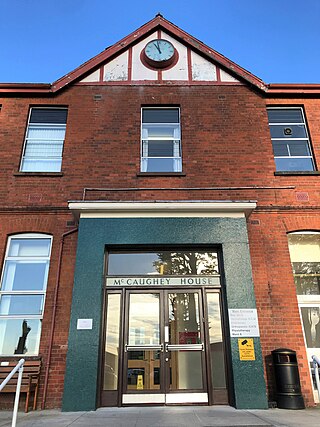
A sanatorium, also sanitarium or sanitorium, is a historic name for a specialised hospital for the treatment of specific diseases, related ailments and convalescence. Sanatoriums are often in a healthy climate, usually in the countryside. The idea of healing was an important reason for the historical wave of establishments of sanatoriums, especially at the end of the 19th- and early 20th centuries. One sought, for instance, the healing of consumptives especially tuberculosis or alcoholism, but also of more obscure addictions and longings of hysteria, masturbation, fatigue and emotional exhaustion. Facility operators were often charitable associations such as the Order of St. John and the newly founded social welfare insurance companies.

The Waverly Hills Sanatorium is a former sanatorium located in the Waverly Hills neighborhood of Louisville, Kentucky.

Westwood is a town in the Rockhampton Region and a locality split between the Rockhampton Region and the Shire of Banana in Queensland, Australia. It was the first town that was gazetted by the Queensland Government. In the 2021 census, the locality of Westwood had a population of 199 people.

Joseph Wilson Fifer was the 19th governor of Illinois, serving from 1889 to 1893. He also served as a member of the Illinois Senate from 1881 to 1883.

The Normal Theater, also known as the Normal Theatre, is a cinema located in the downtown area of Normal, Illinois of the United States of America, which is located in McLean County. The theater closed for a time in the early 1990s but reopened in 1993 after being purchased and renovated by the town of Normal. It has since been in continuous operation, showing a mix of first run and classic films. The building has been on the National Register of Historic Places since July 25, 1997.

Franklin Square, or Franklin Park is located in Bloomington, Illinois, McLean County. Listed on the National Register of Historic Places, Franklin Square contains the homes of former Vice President Adlai Stevenson I and former Governor Joseph W. Fifer. In 1979 the square was designated as a local historic district. Located northeast of downtown Bloomington, the square encompasses the 300 and 400 blocks of E. Chestnut and E. Walnut streets and the 900 block of N. Prairie and N. McLean streets.

Mount McGregor Correctional Facility was a medium security prison for male inmates in the Town of Moreau, Saratoga County, New York, United States. It was served by the Wilton, New York, post office and included 100 structures on over 1,000 acres. Before updating security, it was called "Camp Walkaway" due to the number of breakouts. It became a prison in 1976, housing a maximum of 540 inmates, and eventually closed 38 years later, on July 26, 2014.

The Sanitorium Covered Bridge is a bridged located east of Rockville, Indiana. The single-span Burr Arch covered bridge structure was built by Joseph A. Britton in 1913.

Between 1873 and 1945, Saranac Lake, New York, became a world-renowned center for the treatment of tuberculosis, using a treatment that involved exposing patients to as much fresh air as possible under conditions of complete bed-rest. In the process, a specific building type, the "cure cottage", developed, built by residents seeking to capitalize on the town's fame, by physicians, and often by the patients themselves. Many of these structures are extant, and their historic value has been recognized by listing on The National Register of Historic Places.

Sprague's Super Service is a historic independent gas station on Route 66 in Normal, Illinois. It is listed on the National Register of Historic Places, Town of Normal Local Landmark, and is in the Route 66 Association of Illinois Hall of Fame.

The Adirondack Cottage Sanitarium was a tuberculosis sanatorium established in Saranac Lake, New York in 1885 by Dr. Edward Livingston Trudeau. After Trudeau's death in 1915, the institution's name was changed to the Trudeau Sanatorium, following changes in conventional usage. It was listed under the latter name on the National Register of Historic Places in 1995.

The Seaside is a historic medical facility at 36 Shore Road in Waterford, Connecticut. It is nationally significant as the first institution designed for heliotropic treatment of children suffering from tuberculosis. Its buildings "comprise an exceptional collection of fully realized and generally well-preserved Tudor Revival-style institutional architecture", which were designed by Cass Gilbert. The property was listed on the National Register of Historic Places in 1995.

Florence Fifer Bohrer was an American activist and politician in Illinois. She was the daughter of former Illinois governor Joseph W. Fifer and was the first female senator in the Illinois General Assembly. She served for two terms from 1924 to 1932.
The town of Colorado Springs, Colorado, played an important role in the history of tuberculosis in the era before antituberculosis drugs and vaccines. Tuberculosis management before this era was difficult and often of limited effect. In the 19th century, a movement for tuberculosis treatment in hospital-like facilities called sanatoriums became prominent, especially in Europe and North America. Thus people sought tuberculosis treatment in Colorado Springs because of its dry climate and fresh mountain air. Some people stayed in boarding houses, while others sought the hospital-like facilities of sanatoriums. In the 1880s and 1890s, it is estimated that one-third of the people living in Colorado Springs had tuberculosis. The number of sanatoriums and hospitals increased into the twentieth century. During World War II, medicines were developed that successfully treated tuberculosis and by the late 1940s specialized tuberculosis treatment facilities were no longer needed.

Ethan Allen School for Boys was a reform school in Delafield Town, Wisconsin which operated in a former tuberculosis sanitorium from April 1959 until June 2011, when it was abolished and the inmates moved to Lincoln Hills School in Irma. It was operated by the Wisconsin Department of Corrections.
Markleton is an unincorporated community that is located in Somerset County, Pennsylvania, United States. The community is situated near the Casselman River, 7.7 miles (12.4 km) east-northeast of Confluence.
Baker Park is a 12-hectare (30-acre) urban park on the bank of the Bow River in the west edge of the city of Calgary. It is part of the pedestrian and bicycle Bow River pathway that links a vast network of urban parks on both sides of the river. Baker Park is situated across the river from Bowness Park east of the Bearspaw Water Intake Pump Station. With its river observation point overlooking the Bow River and Bowness Park and its archways and arbours, it is the "most popular" park in Calgary for outdoor weddings.

Whiteabbey Hospital is a hospital located close to the village of Whiteabbey, within the town of Newtownabbey, Northern Ireland. The hospital first opened in 1907 as The Abbey Sanitorium, centred around a country house known as 'The Abbey'. The house has stood on the site from 1850, and was once the residence of prominent architect Charles Lanyon. The hospital was extended and several buildings added throughout the early 20th century, and it was renamed Whiteabbey Hospital in 1947. The hospital is managed by the Northern Health and Social Care Trust. Many healthcare services have been withdrawn from the hospital, most recently with the closure of the Minor Injuries Unit in 2014.



















